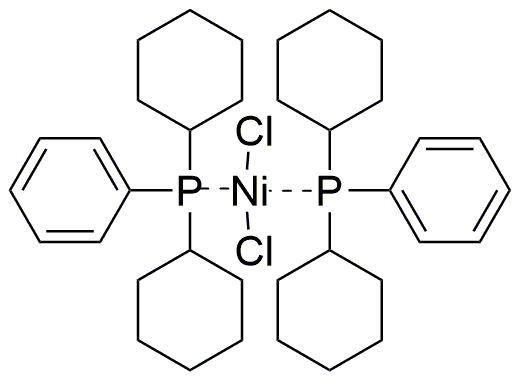Dichlorobis(dicyclohexylphenylphosphine)nickel(II) is widely utilized in research focused on:
- Catalysis: This compound serves as an effective catalyst in various organic reactions, particularly in cross-coupling reactions, which are essential for synthesizing complex organic molecules.
- Material Science: It is used in the development of advanced materials, including polymers and nanomaterials, enhancing their properties through metal coordination.
- Pharmaceuticals: The compound plays a role in drug development, particularly in the synthesis of pharmaceutical intermediates, streamlining the production of active ingredients.
- Environmental Chemistry: It is applied in the study of environmental remediation processes, helping to develop methods for removing pollutants from soil and water.
- Research in Coordination Chemistry: This chemical is crucial for exploring the properties of metal complexes, contributing to advancements in coordination chemistry and its applications in various fields.
General Information
Properties
Safety and Regulations
Applications
Dichlorobis(dicyclohexylphenylphosphine)nickel(II) is widely utilized in research focused on:
- Catalysis: This compound serves as an effective catalyst in various organic reactions, particularly in cross-coupling reactions, which are essential for synthesizing complex organic molecules.
- Material Science: It is used in the development of advanced materials, including polymers and nanomaterials, enhancing their properties through metal coordination.
- Pharmaceuticals: The compound plays a role in drug development, particularly in the synthesis of pharmaceutical intermediates, streamlining the production of active ingredients.
- Environmental Chemistry: It is applied in the study of environmental remediation processes, helping to develop methods for removing pollutants from soil and water.
- Research in Coordination Chemistry: This chemical is crucial for exploring the properties of metal complexes, contributing to advancements in coordination chemistry and its applications in various fields.
Documents
Safety Data Sheets (SDS)
The SDS provides comprehensive safety information on handling, storage, and disposal of the product.
Product Specification (PS)
The PS provides a comprehensive breakdown of the product’s properties, including chemical composition, physical state, purity, and storage requirements. It also details acceptable quality ranges and the product's intended applications.
Certificates of Analysis (COA)
Search for Certificates of Analysis (COA) by entering the products Lot Number. Lot and Batch Numbers can be found on a product’s label following the words ‘Lot’ or ‘Batch’.
Numéro de catalogue
Numéro de lot/série
Certificates Of Origin (COO)
This COO confirms the country where the product was manufactured, and also details the materials and components used in it and whether it is derived from natural, synthetic, or other specific sources. This certificate may be required for customs, trade, and regulatory compliance.
Numéro de catalogue
Numéro de lot/série
Safety Data Sheets (SDS)
The SDS provides comprehensive safety information on handling, storage, and disposal of the product.
DownloadProduct Specification (PS)
The PS provides a comprehensive breakdown of the product’s properties, including chemical composition, physical state, purity, and storage requirements. It also details acceptable quality ranges and the product's intended applications.
DownloadCertificates of Analysis (COA)
Search for Certificates of Analysis (COA) by entering the products Lot Number. Lot and Batch Numbers can be found on a product’s label following the words ‘Lot’ or ‘Batch’.
Numéro de catalogue
Numéro de lot/série
Certificates Of Origin (COO)
This COO confirms the country where the product was manufactured, and also details the materials and components used in it and whether it is derived from natural, synthetic, or other specific sources. This certificate may be required for customs, trade, and regulatory compliance.


